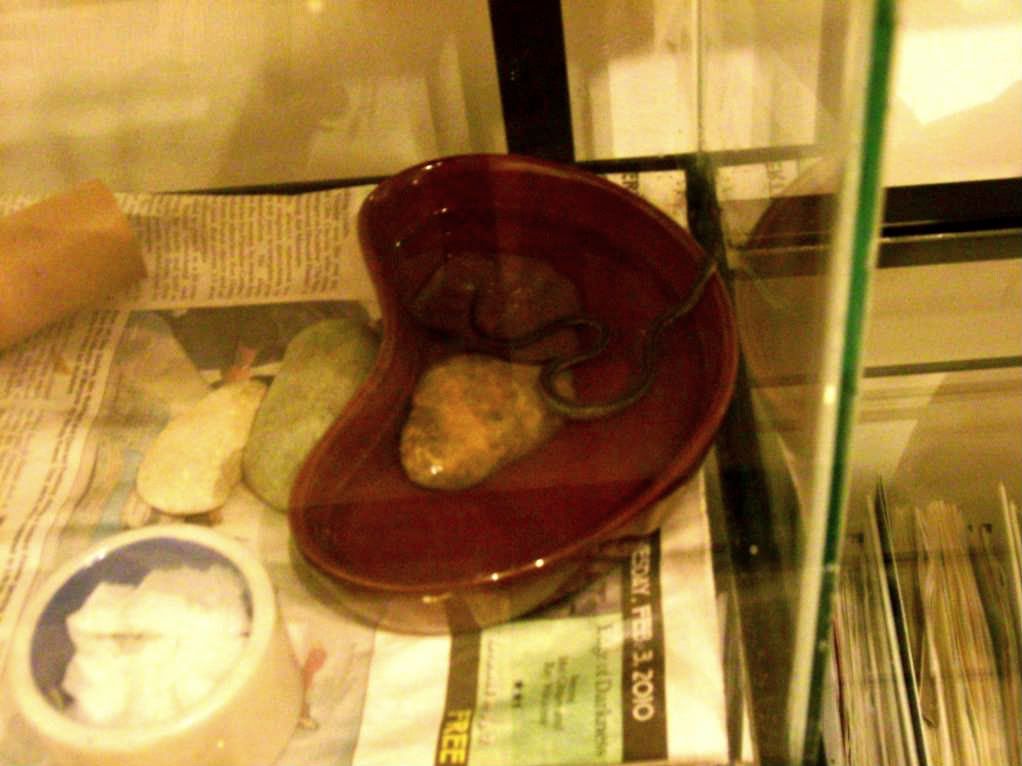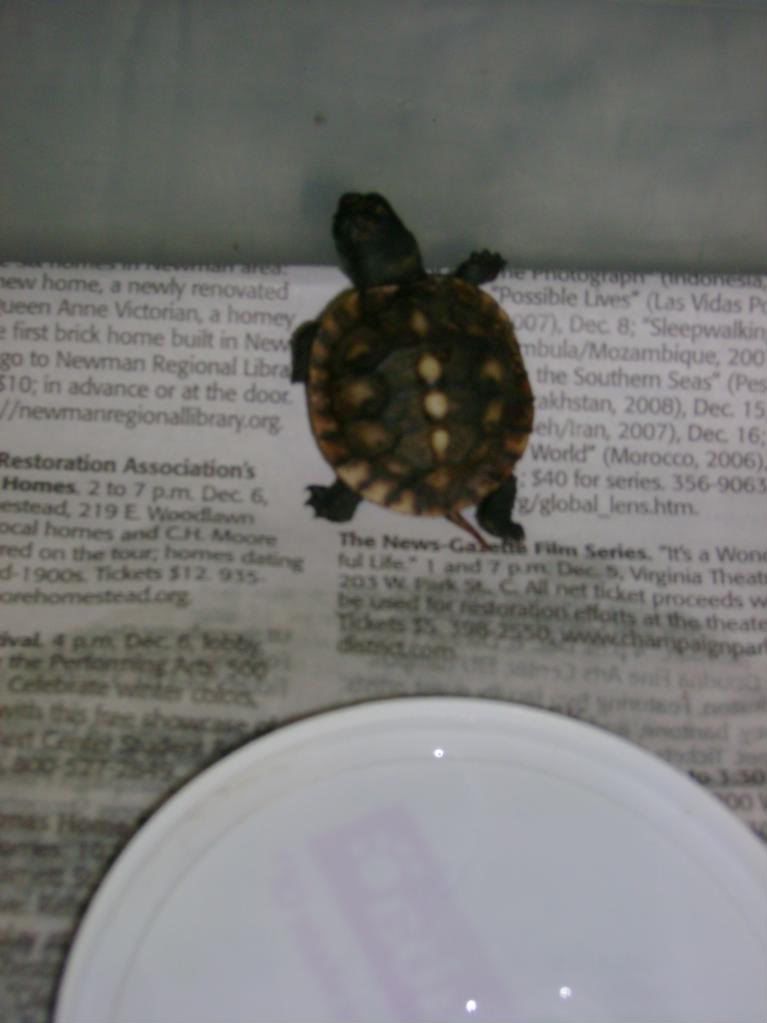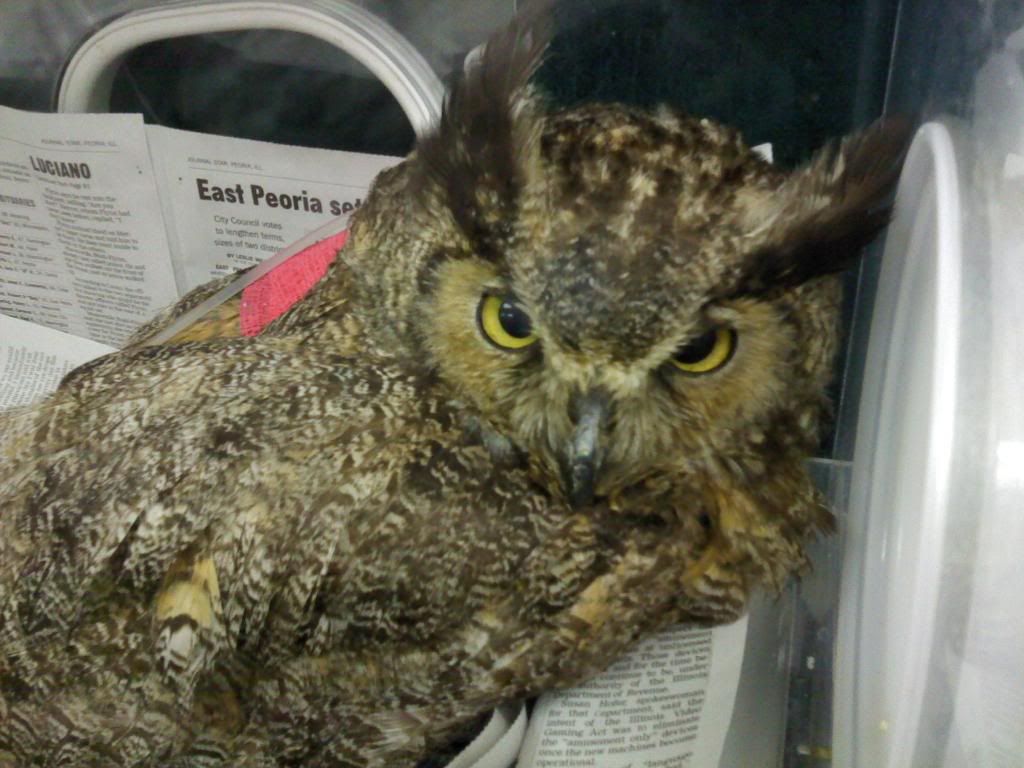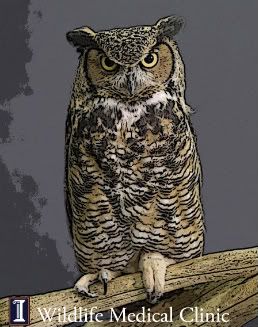As we enter the Holiday season, the Wildlife Medical Clinic is typically visited by fewer patients. Many of our native wildlife have traveled further south or are burrowed in to wait out the long, cold nights. However, our residents are just as busy if not more busy now teaching us humans about their kind. Nokomis, Odin, Noelle, and Pistol have been making appearances all over Champaign County in order to help teach people about what we do at the clinic.
Even though he has not made his public debut, RJ is just as busy as the other raptors. We have been training him to step onto our arms on command, perch, and step into his kennel when asked. The imaginary buttons on our scrubs are pretty much bursting off! We are so proud of our newest addition. As the days keep getting shorter, and the nights (and days) are getting colder, our little friends stay inside. We keep them entertained by working with them and hiding their food in their kennels so they have to "work" a little for it. Yet, we are certain when they tuck their heads in, they are "itching" for spring and warmer weather just like we are.
Sunday, December 5, 2010
Burrowing in for the Holidays
Tuesday, October 26, 2010
A night out for the clinic

Tonight V. Picasso will be holding a fundraiser for the wildlife clinic. From 4-11pm V. Picasso will be donating 20% of your bill(not including alcohol) to the Wildlife Medical Clinic. This is a great opportunity to check out this new tapas bar and the yummy food they have available. It is also a great opportunity to donate to the clinic so we can continue to help and rehabilitate local wildlife. There are over 120 student volunteers that help keep the clinic running and work hard to take care of over 1500 animals annually. This is a fantastic opportunity to thank all of these students and show your support for the wildlife clinic. Remember, you must have previously printed out the V. Picasso flyer to make sure that 20% is donated to the wildlife clinic. If you're anticipating a large group of people then it is best to make reservations. So come out to support the clinic and have a good time.
V. Picasso is located at 214 W. Main St. in Urbana. You can find flyers online here.
Wednesday, September 8, 2010
Something to laugh about!

No, our clinic hasn't turned into a comedy club! We have a new member to add to our already stellar resident bird group. His name is RJ and he is a nine year old Laughing Kookaburra! Already, his cheerful call can be heard echoing throughout the Wildlife Medical Clinic.
RJ came to us from the Miller Park Zoo. At the Zoo, he did not get along with his female roommate. He had to be housed alone and off display. Another interesting thing about RJ is that he has an abnormal right foot and he doesn't like to put all of his weight on it. Here at the WMC, we hope to put him to great use as part of our educational, resident bird program!
RJ is now getting comfortable in his new home. It will take some time, and we will give him all the time he needs.
Kookaburra facts:
- Kookaburras are natives to Australia and New Guinea
- Kookaburras are a type of Kingfisher...but they don't eat fish!
- In the wild, they eat small reptiles, rodents and small birds
- Kookaburras mate for life
- The Kookaburra's children will stay with their parents after they have grown to help raise the next clutch
Monday, March 29, 2010
The Orphans are Coming!
As the weather begins to warm up, the Wildlife Clinic has once again begun receiving orphaned baby animals. In Champaign County, Great Horned Owls begin nesting in February, and our first two orphans of the season have been some baby GHO chicks that were healthy despite falling out of their nests. To minimize imprinting on humans, these babies were transferred to the Illinois Raptor Center as quickly as possible to be raised with surrogates. The GHO's time their reproduction so that the can feed their babies with the bounty of offspring produced by other animals beginning in March. Squirrels are some of the first mammals to bear young, and the clinic has received quite a few litters so far. Cotton Tail Rabbits will begin breeding when temperatures are above 60F. There have been more than a few warm days this March and the clinic has had many litters of rabbits as well. In April, song birds begin nesting and other mammals like raccoons will start to bear young.
 It is important to remember that wild baby animals best left in the wild to be raised by their parents. Being raised by humans results in higher mortality rates due to difficulty feeding, artificial diets, and high stress levels. Mother rabbits only visit the nest twice a day. If you have found a nest of baby bunnies, place crossed sticks or twigs over the nest and come back in 12 hours to see if they have moved. It is a myth that wild animal mothers (be they mammals or birds) will not come back to their offspring if humans have touched them. The maternal instinct will overcome any potential fear caused by the human scent. Like baby rabbits, baby birds should be put back in their nest if found on the ground. If you cannot reach the nest, or if it has been destroyed, a plastic container or box with small holes in the bottom for drainage can be nailed to the tree the birds came from, and the babies can be put in the artificial nest for their parents to find. Of course, if a baby animal is injured, cold to the touch, or has bugs on it, it should be brought to the clinic for medical attention. These are just some very basic guidelines. If you ever have a questions on wildlife, you should speak to an expert such as the clinic (217-244-1195) or your local wildlife rehabber.
It is important to remember that wild baby animals best left in the wild to be raised by their parents. Being raised by humans results in higher mortality rates due to difficulty feeding, artificial diets, and high stress levels. Mother rabbits only visit the nest twice a day. If you have found a nest of baby bunnies, place crossed sticks or twigs over the nest and come back in 12 hours to see if they have moved. It is a myth that wild animal mothers (be they mammals or birds) will not come back to their offspring if humans have touched them. The maternal instinct will overcome any potential fear caused by the human scent. Like baby rabbits, baby birds should be put back in their nest if found on the ground. If you cannot reach the nest, or if it has been destroyed, a plastic container or box with small holes in the bottom for drainage can be nailed to the tree the birds came from, and the babies can be put in the artificial nest for their parents to find. Of course, if a baby animal is injured, cold to the touch, or has bugs on it, it should be brought to the clinic for medical attention. These are just some very basic guidelines. If you ever have a questions on wildlife, you should speak to an expert such as the clinic (217-244-1195) or your local wildlife rehabber.
Sticks Crossed Over Top
to See If Mom Returns
Friday, March 12, 2010
Something's a FOWL in the Wildlife Clinic!
... waterfowl that is! The Wildlife Clinic's waterfowl collection started back just before Valentine's Day when a mallard duck was presented to us with a broken wing. His left humerus was completely broken and a piece of it was bent in the wrong direction! Our ducky valentine underwent surgery and, as you can see in the picture to the left, he has an external fixator holding everything in place while his wing heals. It is predicted that he will not be able to fly once the bone heals, but there is a happy ending awaiting this duck- he has bee n placed on a farm where he can swim all day in the pond and be adored by visiting children. Next added to our collection were two mute swans. They arrived almost a week apart but both presented as weak, lethargic and dehydrated. The first swan was released earlier this week. The second is still with us, being diligently attended to by his team. To the right, he is pictured surrounded by a group of students who are determinedly working to keep him feeling good. The final waterfowl in our current collection is a lesser snow goose, pictured below. He hurt his wing in the process of migrating up to the Arctic and he is now waiting, impatiently, for his wing to mend so he can continue his long journey. Snow geese are not something we see frequently in the wildlife clinic, but that does not mean they are an uncommon sight in our area! In as early as October you can see flocks of them heading south for the winter. They go as far south as Central America and then, in February, you can see them heading back up north toward the Arctic. We wish our goose a fast recovery and a safe journey home!
n placed on a farm where he can swim all day in the pond and be adored by visiting children. Next added to our collection were two mute swans. They arrived almost a week apart but both presented as weak, lethargic and dehydrated. The first swan was released earlier this week. The second is still with us, being diligently attended to by his team. To the right, he is pictured surrounded by a group of students who are determinedly working to keep him feeling good. The final waterfowl in our current collection is a lesser snow goose, pictured below. He hurt his wing in the process of migrating up to the Arctic and he is now waiting, impatiently, for his wing to mend so he can continue his long journey. Snow geese are not something we see frequently in the wildlife clinic, but that does not mean they are an uncommon sight in our area! In as early as October you can see flocks of them heading south for the winter. They go as far south as Central America and then, in February, you can see them heading back up north toward the Arctic. We wish our goose a fast recovery and a safe journey home!
Tuesday, March 2, 2010


It is the eve of the 9th annual Doodle for Wildlife! We have some very exciting celebrity doodles and wonderful prize packages up for auction. Of course we also have some very special artwork from our own in-house celebrities: our resident raptors! Our birds have generously donated some of their finest "wing painted" artwork for auction. They are anxiously awaiting their public's response to the paintings this year. In the past the stunning pieces that our raptors paint have been some of our biggest successes in raising money for the wildlife clinic. Pictured above is a piece that was auctioned off at last year's Doodle event. The Wildlife Medical Clinic depends on the donations we receive and the money we raise from Doodle in order to keep running. Our resident birds go to great lengths to create these paintings for us and help the clinic's cause. Nokomis, our resident Great Horned Owl, had a couple of orange feathers for a week after creating his piece this year. In a private interview, he assured me that "it was little price to pay for the sake of my art." As you can see our birds take their artwork very seriously and we appreciate their efforts to help raise money for the clinic!
Friday, February 19, 2010
Bald Eagle in the News!
In case you missed the WMC on the news this evening, here's a couple of links:
WAND Stormcenter 17
WICD ABC 15 :: Top Stories
Bald Eagle in the News!
Catch a news story on the bald eagle that is currently in the Clinic on tonight's 6pm newscast on WAND-TV 17 or check out the story on the website after tonight's broadcast
Saturday, February 13, 2010
Why is there a snake in my basement in winter?
A couple weeks ago, a plains garter snake (Thamnophis radix) presented at the clinic after someone found the young snake in their basement. Why would a snake be active in the middle of winter when it should be hibernating? Actually, reptiles do not go through a true hibernation like mammals. Instead, they undergo brumation. True hibernation results in an animal going dormant in the fall and remaining so until spring. During brumation, the cold environmental temperature significantly lowers a reptile's body temperature, causing it to be less active and have a lower metabolism, but not to be truly asleep. This allows a brumanating reptile to "wake up" for periods of time. As a result, it is not uncommon for snakes to end up in a basement during the winter if they are trying to move deeper in the earth to escape dips in temperature. Box turtles have also been shown to move higher and lower in the soil in response to changes in winter temperatures, and there also was a young box turtle that came into the clinic recently.
For a reptile found in the winter, it can either be induced into an artificial brumation, or it can be kept awake, warm, and eating until it can be released in spring. This garter snake was also suffering from "hibernation sores," the result of opportunistic infections that occur from a reptile's immune system not functioning as well due to its lowered metabolism. As a result, it was decided to keep the snake awake to give it the best chance to recover. Now, after shedding its skin, almost all the sores are healed. If you find a reptile in the winter, bring it to the Wildlife Medical Clinic or a local wildlife rehabber to give it the best chance for survival.
The Garter Snake Enjoying a Soak

The Young Box Turtle

Friday, February 5, 2010
The Many Roles of the Resident Raptors
Many of you who are familiar with our resident birds of prey from the Wildlife Medical Clinic know them from the Public Relations events they do throughout the community. Although helping to teach people about wildlife and wildlife safety is a very big part of the residents' job, these five special birds also play another role in the clinic. Occasionally, they help to save the lives of very debilitated patients by serving as blood donors. This was the case a couple weeks ago, when the very rare event of having not just one but two patients that needed transfusion occurred. The first patient that presented was a Great Horned Owl (Bubo virginianus). This owl was lying sternal, or on its belly, when it came in, which is a sign that a wild animal is feeling very ill. She was emaciated, having almost no muscles on the breast bone, where the large flight muscles are normally found. Blood work showed the owl was also very anemic. Winter is very hard on raptors, and it is not uncommon for hawks and owls to come in to the clinic this time of year suffering from similar symptoms, though this Great Horned Owl was especially weak.
Normal fluid therapy was not going to be sufficient in such a debilitated patient, and after conferring with the doctors, it was decided to have Nokomis, our resident Great Horned Owl, serve as a blood donor to give the patient the best chance for survival. Nokomis was anesthetized to collect 10mL or about 1% of his blood volume, which was then slowly transfused to the new owl through a special line with a filter to remove any clots that may have formed.
Just as the transfusion in the owl was being finished, another patient arrived at the clinic. This one was a juvenile Red Tailed Hawk (Buteo jamaicensis )that had almost identical problems to owl. Once again, the decision was made to perform a transfusion to give the starving hawk the best chance of survival. Odin, our 13 year old resident Red Tail, served as the donor this time. It was a very late night before everything was completed, but over the next few days both transfusion patients improved, beginning to stand on their own and look more alert. Both Nokomis and Odin did very well after donating their blood, and each received extra TLC to thank them for their contributions! To meet Odin, Nokomis, or any of our other resident raptors and to learn more about wildlife, visit our main website to schedule a PR event for your group. http://vetmed.illinois.edu/wmc/pr_visits.html
Getting Ready to Place an IV in a leg vein for the Red-Tailed Hawk
The Great Horned Owl Resting After the Transfusion








